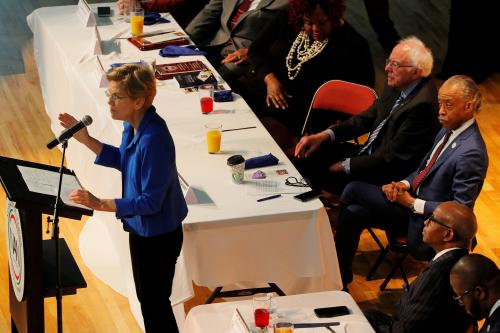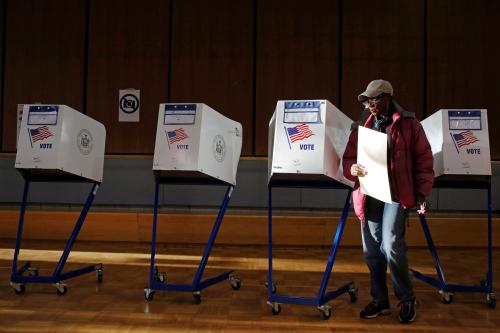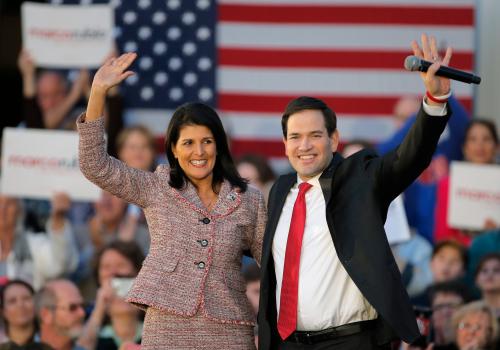With Alabama being neither one of the four “early states” (Iowa, New Hampshire, Nevada, and South Carolina) nor one of the most delegate-rich prizes on Super Tuesday (California and Texas), Alabama has suffered a dearth of polling for the Democratic primary. In fact, the last poll of the state was conducted over the summer; according to FiveThirtyEight, the latest poll of the Alabama presidential primary was conducted by SurveyMonkey between July 2–16, 2019. This poll showed former Vice President Joe Biden with a comfortable lead (21 points) over the second-place contender, Senator Bernie Sanders. But a lot has happened since the summer, and nobody has taken the pulse of Alabama Democrats since then. With pollsters most likely to focus on California, Texas, and to a lesser extent Virginia once the focus shifts to Super Tuesday, there will almost certainly not be a huge number of Alabama polls even then.
Alabama Democrats are relatively moderate compared to their Republican counterparts, with 57% identifying as liberal, 32% as moderate, and 11% as conservative in 2016 exit polls. Seventy-eight percent of Republican primary voters in Alabama identified as conservative in the same exit poll. In a 2014 Pew study, only 24% of Alabama Democrats identified as liberal, while 65% of Alabama Republicans identified as conservative. Comparative moderation might influence voting decisions, as voters are likely to rate a candidate’s perceived electability as a high priority, and electability considerations will be shaped by the conservative political environment of the state, which stands to influence the content of self-identified ideological labels such as “liberal”.
While it is highly unlikely (one might say close to impossible) that any Democrat will carry the state of Alabama in November (the last time Alabama voted for a Democratic nominee for President was 1976, when Jimmy Carter won the state by a comfortable margin), Alabama Democrats will also likely decide who to cast their vote for based on who does the most good (or the least harm) to Sen. Doug Jones’ re-election chances in November. Jones, who narrowly won his seat in a special election in 2017, is expected to face an uphill battle this year. The race has recently been changed from “toss up“ to “lean Republican“ by Cook Political Report and current polls suggest that Jones is likely to face former incumbent Jeff Sessions in the general election. With Donald Trump’s approval rating in the state (+23; tie with Idaho) being second only to that in Wyoming (+27) and Jeff Sessions running unopposed in his last re-election effort, it is more than likely that Alabamians will in part base their choice of nominee not only on who they think has the best chance of winning the presidency, but also who is least likely to further diminish Doug Jones’ chances.
Another important dynamic at work in the Alabama primary is the composition of the expected Democratic electorate. Like in all open primary states, there is a chance that partisans of the opposing party will choose to participate in the other party’s primary, especially if their own party does not have a competitive primary. However, in previous states there has only been limited evidence for an increased influx of (former) Republicans into the Democratic primary electorate. Furthermore, moderate to center-right independents (a group that is expected to participate more heavily in the Democratic primary this year than in previous years) are a less prevalent group in Alabama, where conservatives are growing in numbers (from 44% of all adults to 50% of all adults between 2007 and 2014), than in other, more competitive states.
In 2016, 54% of Democratic primary voters in Alabama were Black, a number that was topped only by Mississippi (71%) and South Carolina (61%). Former Vice President Joe Biden has been enjoying a comfortable lead among Black voters both nation-wide and in South Carolina and won Black voters by a 12-point margin in the Nevada caucuses, but there is no recent polling of Black voters in Alabama. Former New York City Mayor Michael Bloomberg has been increasing his political advertising presence in Alabama (in late February, Bloomberg made up 89% of ad spending in Alabama, according to CNN) and it remains to be seen if this allows him to make inroads with Alabama Democrats prior to the election on March 3. This combination of a lack of polling, a primary electorate that differs both demographically as well as ideologically from that of other early states, and the still somewhat fluid state of the overall race ahead of the South Carolina primary makes it hard to predict who is likely to win Alabama, though from what we know it should be relatively favorable to former Vice President Biden.
Note: The original version of this post stated that Sen. Doug Jones was elected in 2018. He was elected in 2017 and took office in 2018.
The Brookings Institution is committed to quality, independence, and impact.
We are supported by a diverse array of funders. In line with our values and policies, each Brookings publication represents the sole views of its author(s).








Commentary
In the Alabama presidential primary, Doug Jones may be on Democrats‘ minds
February 26, 2020